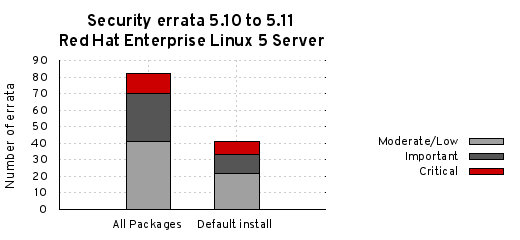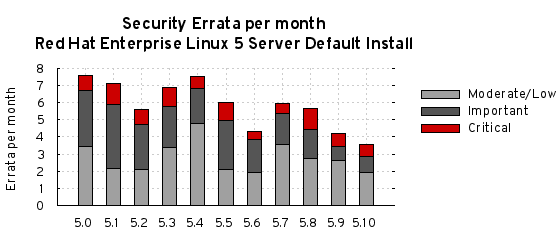Red Hat Enterprise Linux 5.11 was released this month (September 2014), eleven months since the release of 5.10 in October 2013. So, as usual, let’s use this opportunity to take a look back over the vulnerabilities and security updates made in that time, specifically for Red Hat Enterprise Linux 5 Server.
Red Hat Enterprise Linux 5 is in Production 3 phase, being over seven years since general availability in March 2007, and will receive security updates until March 31st 2017.
<!–Red Hat is transitioning to Red Hat Subscription Management for all Red Hat products by July 31, 2017. All systems registered as clients to Red Hat Network Classic Hosted directly, or indirectly with Red Hat Proxy, must be migrated to Red Hat Subscription Management by July 31, 2017.–>
Errata count
The chart below illustrates the total number of security updates issued for Red Hat Enterprise Linux 5 Server if you had installed 5.10, up to and including the 5.11 release, broken down by severity. It’s split into two columns, one for the packages you’d get if you did a default install, and the other if you installed every single package.
Note that during installation there actually isn’t an option to install every package, you’d have to manually select them all, and it’s not a likely scenario. For a given installation, the number of package updates and vulnerabilities that affected your systems will depend on exactly what you selected during installation and which packages you have subsequently installed or removed.
 For a default install, from release of 5.10 up to and including 5.11, we shipped 41 advisories to address 129 vulnerabilities. 8 advisories were rated critical, 11 were important, and the remaining 22 were moderate and low.
For a default install, from release of 5.10 up to and including 5.11, we shipped 41 advisories to address 129 vulnerabilities. 8 advisories were rated critical, 11 were important, and the remaining 22 were moderate and low.
For all packages, from release of 5.10 up to and including 5.11, we shipped 82 advisories to address 298 vulnerabilities. 12 advisories were rated critical, 29 were important, and the remaining 41 were moderate and low.
You can cut down the number of security issues you need to deal with by carefully choosing the right Red Hat Enterprise Linux variant and package set when deploying a new system, and ensuring you install the latest available Update release.
Critical vulnerabilities
Vulnerabilities rated critical severity are the ones that can pose the most risk to an organisation. By definition, a critical vulnerability is one that could be exploited remotely and automatically by a worm. However we also stretch that definition to include those flaws that affect web browsers or plug-ins where a user only needs to visit a malicious (or compromised) website in order to be exploited. Most of the critical vulnerabilities we fix fall into that latter category.
The 12 critical advisories addressed 33 critical vulnerabilities across just three different projects:
- An update to NSS/NSPR: RHSA-2014:0916(July 2014). A race condition was found in the way NSS verified certain certificates which could lead to arbitrary code execution with the privileges of the user running that application.
- Updates to PHP, PHP53: RHSA-2013:1813, RHSA-2013:1814
(December 2013). A flaw in the parsing of X.509 certificates could allow scripts using the affected function to potentially execute arbitrary code. An update to PHP: RHSA-2014:0311
(March 2014). A flaw in the conversion of strings to numbers could allow scripts using the affected function to potentially execute arbitrary code. - Updates to Firefox, RHSA-2013:1268 (September 2013), RHSA-2013:1476 (October 2013), RHSA-2013:1812 (December 2013), RHSA-2014:0132 (February 2014), RHSA-2014:0310 (March 2014), RHSA-2014:0448 (Apr 2014), RHSA-2014:0741 (June 2014), RHSA-2014:0919 (July 2014) where a malicious web site could potentially run arbitrary code as the user running Firefox.
Updates to correct 32 of the 33 critical vulnerabilities were available via Red Hat Network either the same day or the next calendar day after the issues were public.
Overall, for Red Hat Enterprise Linux 5 since release until 5.11, 98% of critical vulnerabilities have had an update available to address them available from the Red Hat Network either the same day or the next calendar day after the issue was public.
Other significant vulnerabilities
Although not in the definition of critical severity, also of interest are other remote flaws and local privilege escalation flaws:
- A flaw in glibc, CVE-2014-5119, fixed by RHSA-2014:1110 (August 2014). A local user could use this flaw to escalate their privileges. A public exploit is available which targets the polkit application on 32-bit systems although polkit is not shipped in Red Hat Enterprise Linux 5. It may be possible to create an exploit for Red Hat Enterprise Linux 5 by targeting a different application.
- Two flaws in squid, CVE-2014-4115, and CVE-2014-3609, fixed by RHSA-2014:1148 (September 2014). A remote attacker could cause Squid to crash.
- A flaw in procmail, CVE-2014-3618, fixed by RHSA-2014:1172 (September 2014). A remote attacker could send an email with specially crafted headers that, when processed by formail, could cause procmail to crash or, possibly, execute arbitrary code as the user running formail.
- A flaw in Apache Struts, CVE-2014-0114, fixed by RHSA-2014:0474 (April 2014). A remote attacker could use this flaw to manipulate the ClassLoader used by an application server running Stuts 1 potentially leading to arbitrary code execution under some conditions.
- A flaw where yum-updatesd did not properly perform RPM signature checks, CVE-2014-0022, fixed by RHSA-2014:1004 (Jan 2014). Where yum-updatesd was configured to automatically install updates, a remote attacker could use this flaw to install a malicious update on the target system using an unsigned RPM or an RPM signed with an untrusted key.
- A flaw in the kernel floppy driver, CVE-2014-1737, fixed by RHSA-2014:0740 (June 2014). A local user who has write access to /dev/fdX on a system with floppy drive could use this flaw to escalate their privileges. A public exploit is available for this issue. Note that access to /dev/fdX is by default restricted only to members of the floppy group.
- A flaw in libXfont, CVE-2013-6462, fixed by RHSA-2014:0018 (Jan 2014). A local user could potentially use this flaw to escalate their privileges to root.
- A flaw in xorg-x11-server, CVE-2013-6424, fixed by RHSA-2013:1868 (Dec 2013). An authorized client could potentially use this flaw to escalate their privileges to root.
- A flaw in the kernel QETH network device driver, CVE-2013-6381, fixed by RHSA-2014:0285 (March 2014). A local, unprivileged user could potentially use this flaw to escalate their privileges. Note this device is only found on s390x architecture systems.
Note that Red Hat Enterprise Linux 5 was not affected by the OpenSSL issue, CVE-2014-0160, “Heartbleed”.
Previous update releases
We generally measure risk in terms of the number of vulnerabilities, but the actual effort in maintaining a Red Hat Enterprise Linux system is more related to the number of advisories we released: a single Firefox advisory may fix ten different issues of critical severity, but takes far less total effort to manage than ten separate advisories each fixing one critical PHP vulnerability.
To compare these statistics with previous update releases we need to take into account that the time between each update release is different. So looking at a default installation and calculating the number of advisories per month gives the following chart:
 This data is interesting to get a feel for the risk of running Enterprise Linux 5 Server, but isn’t really useful for comparisons with other major versions, distributions, or operating systems — for example, a default install of Red Hat Enterprise Linux 4AS did not include Firefox, but 5 Server does. You can use our public security measurement data and tools, and run your own custom metrics for any given Red Hat product, package set, time scales, and severity range of interest.
This data is interesting to get a feel for the risk of running Enterprise Linux 5 Server, but isn’t really useful for comparisons with other major versions, distributions, or operating systems — for example, a default install of Red Hat Enterprise Linux 4AS did not include Firefox, but 5 Server does. You can use our public security measurement data and tools, and run your own custom metrics for any given Red Hat product, package set, time scales, and severity range of interest.
See also:
5.10, 5.9, 5.8, 5.7, 5.6, 5.5, 5.4, 5.3, 5.2, and 5.1 risk reports.